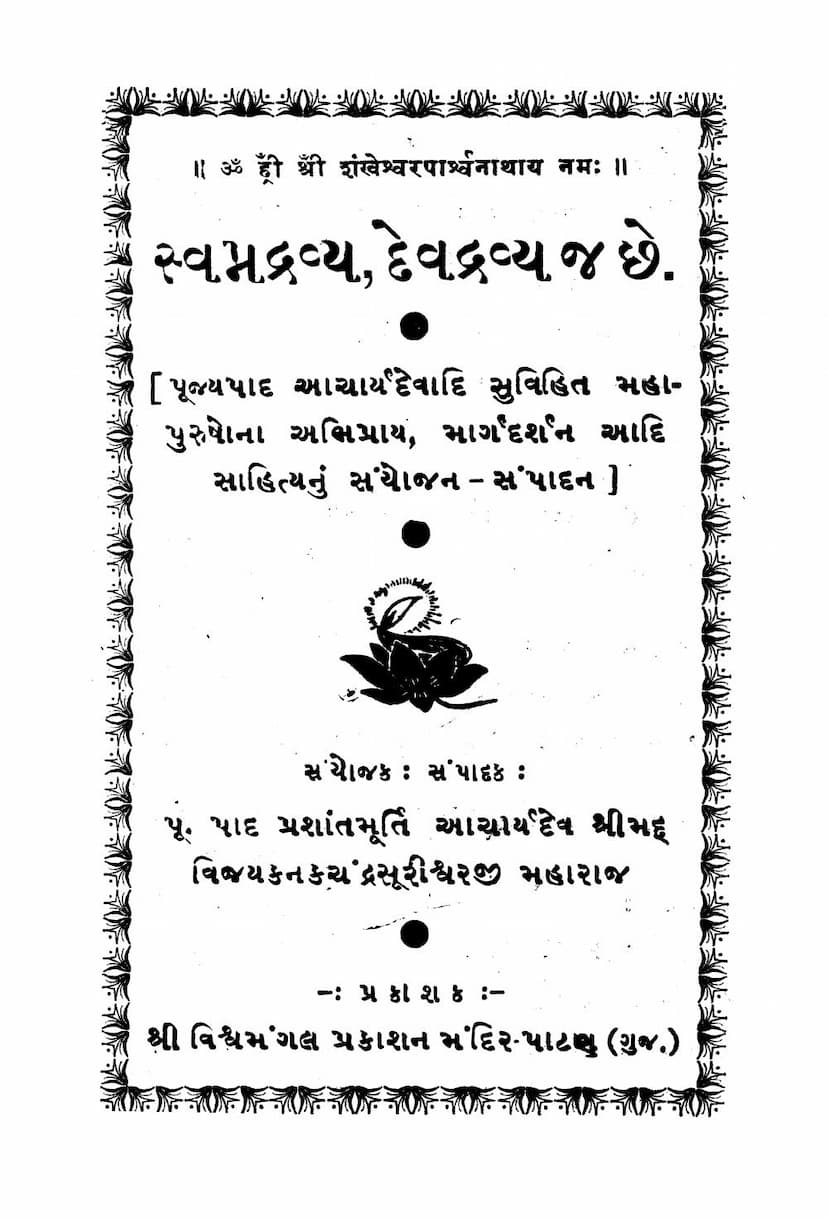Swapnadravya Devdravya J Che
Added to library: September 2, 2025

Summary
Here's a comprehensive summary of the Jain text "Swapnadravya Devdravya J Che" by Kanakchandrasuri, based on the provided content:
Book Title: Swapnadravya Devdravya J Che (Meaning: "Swapnadravya is Devdravya") Author/Compiler: Acharya Shrimad Vijay Kanakchandrasurishwarji Maharaj Publisher: Shri Vishvamangal Prakashan Mandir, Patan (Gujarat) Key Theme: The central argument of the book is that Swapnadravya (literally "dream substance," referring to offerings made during the auction of blessings or vows, typically during Paryushan festival, often related to ghee or other items) is indeed Devdravya (Divine Substance).
Core Argument and Purpose:
The book directly addresses a contemporary debate within the Jain community (specifically, the Shvetambar Murtipujak Sangh) that arose in the preceding decades. Some individuals or groups were advocating for the reclassification of Swapnadravya, suggesting it should be moved from the "Devdravya" account to the "Sadharan" (general or common) account. This reallocation was often proposed to cover general expenses or potentially personal uses, sometimes by increasing the bidding price and attributing the surplus to the common fund.
This book, compiled and edited by Acharya Vijay Kanakchandrasurishwarji Maharaj, serves as a strong rebuttal to this trend. It aims to:
- Reaffirm the Scriptural Truth: To strongly emphasize and prove, based on Jain scriptures and the pronouncements of revered Acharyas and Muni Bhagwants, that Swapnadravya is unequivocally Devdravya.
- Counter Misinterpretations: To refute the notion that Swapnadravya should be treated as ordinary or common substance.
- Highlight the Importance of Devdravya: To explain the sacred nature of Devdravya, the virtue gained from its protection, and the severe sin incurred by its misuse.
- Provide Guidance: To offer clear guidance on the proper protection, utilization, and preservation of Devdravya, especially in relation to "Guru Pujan" (worship of the Guru).
Key Contents and Arguments:
The book is structured into four main sections:
- Scripturally Sound Decision: This section likely presents the foundational scriptural evidence and pronouncements from eminent Jain scholars and saints that firmly establish Swapnadravya as Devdravya.
- Facts Accepted and Taught by Foremost Scholars: This part probably details the consensus and teachings of highly respected Jain monks and spiritual leaders on the matter.
- The Necessity of Boldly Propagating Scriptural Traditions: This section emphasizes the need to fearlessly spread and uphold the traditional understanding of Swapnadravya as Devdravya, countering any deviation.
- How to Protect and Utilize Devdravya: This section provides practical guidance on the correct management, protection, and appropriate use of Devdravya. It specifically addresses the misconception that Guru Pujan funds can be diverted to "Vaiyavach" (service to monks) if not directly for the Guru's worship, asserting that Guru Pujan funds are also Devdravya and cannot be simply reallocated.
Evidence and Support:
The book is rich with:
- Opinions and Letters of Revered Acharyas: Numerous letters and opinions from prominent Jain Acharyas across India are included, all consistently supporting the view that Swapnadravya is Devdravya. These letters address specific queries and refute the idea of reclassifying it.
- Historical Correspondence: The book features correspondence, particularly between the Shanta Cruz Jain Sangh and various Acharyas, initiated in 1938 (Samvat 1994). This correspondence highlights the core issue and the clear scriptural stance of the Acharyas.
- Resolutions from Muni Sammelans (Gatherings of Monks): The book references and includes resolutions from significant Muni Sammelans (e.g., held in Ahmedabad in 1990), where the principle of Swapnadravya being Devdravya was unanimously reaffirmed.
- Scriptural References: The text draws heavily on Jain scriptures like "Sen Prashna," "Hir Prashna," "Shraddh Vidhi," and "Dravya Saptatika" to support its arguments. It clarifies the reasoning behind this classification, linking it to the fourteen dreams seen by the mother of a Tirthankar, signifying auspicious divine events.
- Refutation of Counterarguments: The book addresses and refutes attempts to misinterpret scriptures or the sayings of revered figures like Acharya Vijayananandsurishwarji (Atmaramji) Maharaj to justify the misclassification of Swapnadravya. It highlights that the purpose of such offerings is Dharma Prabhavana (propagation of Dharma) and growth of Jin Dravya, which leads to the accumulation of merit.
Key Takeaway:
The overarching message is a strong call to uphold the sanctity of Devdravya, particularly Swapnadravya. It urges the Jain community to adhere to scriptural injunctions and the teachings of revered Acharyas, emphasizing that any deviation not only misinterprets the scriptures but also incurs grave sin and harms the spiritual progress of the individual and the community. The book aims to educate and guide the Sangha to protect and utilize divine wealth according to its intended sacred purpose.
Historical Context:
The book serves as a historical document, preserving the authoritative pronouncements of prominent Jain scholars and the collective wisdom of the Sangha on a critical theological and financial matter, aimed at safeguarding the integrity of Jain religious practices and institutions.